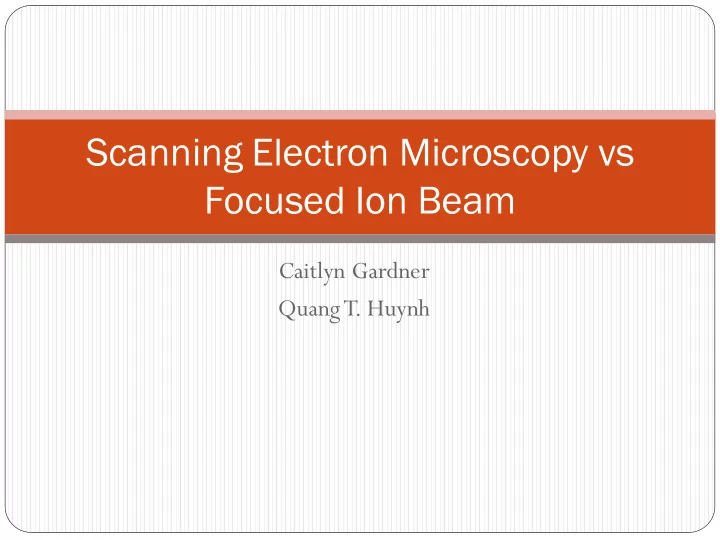

Scanning Electron Microscopy vs Focused Ion Beam Caitlyn Gardner Quang T. Huynh
Concepts and fundamentals of Scanning Electron Microscopes Diffraction limit of light Any atoms are small than half of a wavelength of light is too small to see with light microscope Electrons have much shorter wavelength than light Secondary electrons Scattered electrons X-rays Auger electrons Specimen current
Application of SEM Generate high-resolution images ( in nano-scales) Texture Chemical composition Examine microfabric and crystallography orientation in materials
SEM Components Electron source (“Gun”) Electron lenses Sample Stages Detectors for all signals of interest Display/Data output devices Infrastructure requirements: Power Supply Vacuum system Cooling system Vibration-free floor Room free of ambient magnetic and electric field
Structure of a SEM Figure: Typical structure of scanning electron microscope [1]
Radiolarian Magnification: X 2,000 Magnification: X 500 Figure 2: Radiolarian [6]
Advantages High magnification from 10 to 500,000x By 2009, the world’s highest SEM resolution is 0.4nm at 30kV Can be applied to wide range of applications in the study of solid materials Large depth of field Easy to operate with user-friendly interfaces Highly portable Safe to operate
Disadvantages Sample must be solid and small enough to fit in the chamber Vacuum Some light elements can not be detected by EDS detectors Many instruments cannot detect elements with atomic numbers less than 11 Low conductivity sample must have conductive coating to prevent damage from conventional SEMs
Focused Ion Beam (FIB) Similar to SEM Energized Ga+ ions Applications Sputtering (Ion Milling) Imaging Circuit Edit Figure: FIB system [4]
Sputtering And Imaging Strengths Ability to cross-section small targets High beam current Fast, high resolution imaging with good grain contrast sputtering Very precise milling Low beam current Good SEM sample prep imaging Limitations Vacuum Imaging process may spoil subsequent analyses Residual Ga Ion beam damage- lowered resolution
Circuit Edit Strengths Repair mistakes (multiple Modifications can be made to possible) circuits Quicker, easier, cheaper than new set in fab lab Cut traces or add metal connections Performance optimization Limitations Navigation system Backside modifications are time consuming Smaller features- more complex
Dual Beam Combination of SEM and FIB systems Accurate ion milling or deposition of materials with high resolution imaging
References [1] Digivick, Delicate . [Online].Available: http://www.digitalsmicroscope.com/scanning-electron-microscope- 5.[10/11/2011]. [2] EAG, “Focused Ion Beam (FIB)”. [Online]. Available: http://www.eaglabs.com/techniques/analytical_techniques/fib.php. [10/8/2011]. [3] IBM, “Focused Ion Beam (FIB)”. [Online]. Available: http://www.almaden.ibm.com/st/scientific_services/materials_analysis/fib/. [10/8/2011]. [4] M. Brucherseifer , “SEM/ FIB”. [Online]. Available: http://www.brucherseifer.com/html/sem___fib.html. [10/8/2011]. [5] Swapp S, “Scanning Electron Microscopy( SEM)”. [Online]. Available:http://serc.carleton.edu/research_education/geochemsheets/technique s/SEM.html. [10/9/2011] [ 6]Museum of Science .[Online].Available:http://www.mos.org/sln/SEM/newradio.html
Recommend
More recommend